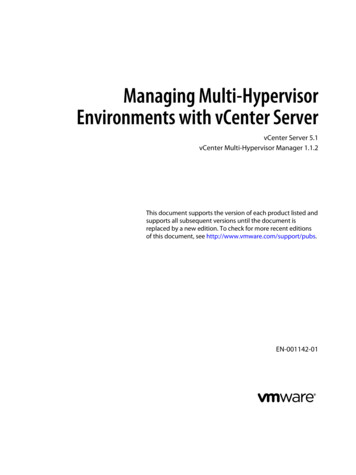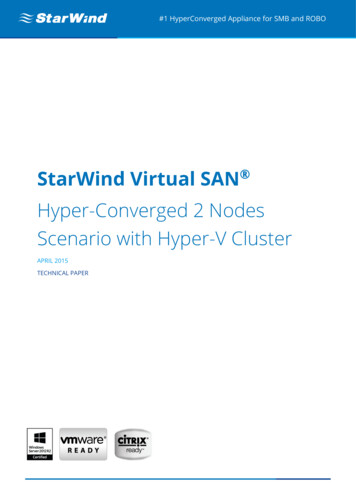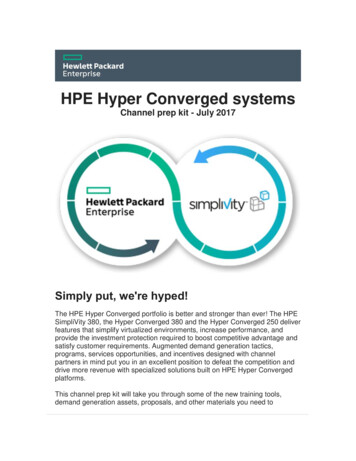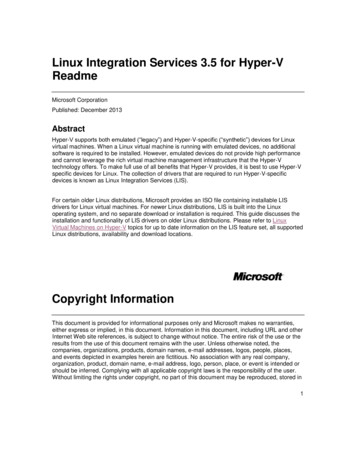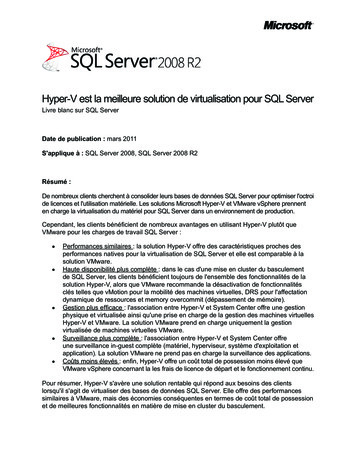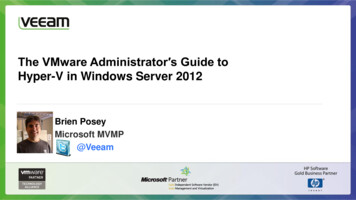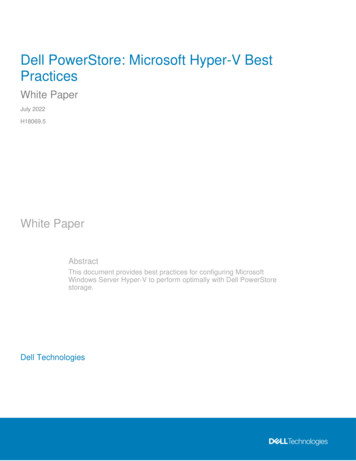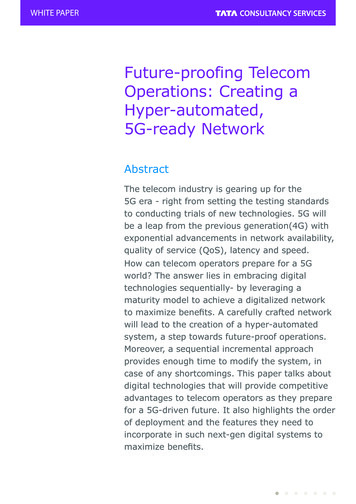
Transcription
WHITE PAPERFuture-proofing TelecomOperations: Creating aHyper-automated,5G-ready NetworkAbstractThe telecom industry is gearing up for the5G era - right from setting the testing standardsto conducting trials of new technologies. 5G willbe a leap from the previous generation(4G) withexponential advancements in network availability,quality of service (QoS), latency and speed.How can telecom operators prepare for a 5Gworld? The answer lies in embracing digitaltechnologies sequentially- by leveraging amaturity model to achieve a digitalized networkto maximize bene ts. A carefully crafted networkwill lead to the creation of a hyper-automatedsystem, a step towards future-proof operations.Moreover, a sequential incremental approachprovides enough time to modify the system, incase of any shortcomings. This paper talks aboutdigital technologies that will provide competitiveadvantages to telecom operators as they preparefor a 5G-driven future. It also highlights the orderof deployment and the features they need toincorporate in such next-gen digital systems tomaximize bene ts.
WHITE PAPEREnabling 5G: Digital technologiesto the rescue5G networks are expected to support download speeds of 20Gbps or higher and network latency of 1 millisecond or less.The ubiquitous network is projected to provide 100 Mbpsconnection anywhere. Achieving these milestones requires newtechnologies and an entire new way of thinking around how thenetwork is structured. In the current scenario, networkmodi cations take days or even months to implement, limitingthe adaptability of the network. In the 5G environment, thenetwork is expected to change characteristics in real time. Thenumber of network changes and frequency of scaling will behigher. In such a scenario, a static environment coulddrastically increase the cost of network operations. How cantelecom operators build a 5G-ready network?When it comes to making existing telecom networks 5G-ready,the following key digital technologies come into play:Virtualization technologies like Software De ned Network(SDN), together with Network Function Virtualization (NFV),decouples hardware and software to create a centralizedmanagement and change center. This allows network changesto be made in real time through an orchestration module, whilereducing cost, time and inertia of network modi cations,increasing network reliability and resiliency.Arti cial intelligence (AI), when coupled with SDN, resultsin real time implementation of modi cations leading to ef cientreal-time monitoring and proactive fault prevention. This is thepath to hyper-automation.Microservices brings modularity and agility to applications inthe network.IoT is expected to form a major portion of telecom traf c inthe future. 5G networks should be ready to handle variouskinds of IoT traf c in a seamless and cost-effective manner.Network slicing and Edge computing are the two key networktechnologies being considered to make existing core networksIoT-ready.
WHITE PAPERAdopting a maturity model for creating a5G–ready network5G-enabling technologies cannot be implemented in anarbitrary manner. Adopting a maturity model that de nes thesequence in which technologies must be implemented can helpmaximize the value of 5G initiatives. Digital technologies suchas AI enhance edge computing while SDN and NFV optimizethe network potential. In essence, a carefully crafted networkwill lead to the creation of a hyper-automated system thatrequires minimal or no human intervention. Moreover, such anapproach allows telecom operators to modify their system overtime to address any shortcomings.SystemsTransformation from legacy networks to cloud is the startingpoint of network transformation. The ideal way to undertakecloud transformation is to test it on the part of the networkthat is non-critical in nature, in order to iron out thebottlenecks and create standard operating procedures (SOPs).Once these are in place, the cloud transformation exercise canmove to the critical part(s) of the network. The steps involvedin network transformation leveraging the proposed maturitymodel (as illustrated in Figure 1) include:Automated SystemsNetworkApplicationsSecurityPreventive SecurityAutoma onDetection &Response SecurityData Analytics/Big DataData AnalyticsHyper Automa onPredictive & Prescriptive SecurityPredictive AIPrescriptive AISelf-FunctioningAIEdge ComputingVirtualizationSoftware DefinedNetwork (SDN)Network FunctionVirtualization (NFV)Network SlicingSequenceFigure 1: Maturity model for creating a 5G-ready telecom network
WHITE PAPERImplementing SDN: Here, the control plane from the nodes(routers/switches) is brought to the central server and put intoa module called SDN controller.Virtualizing functions through NFV: This enables thecreation of an orchestration platform that controls and managesfunctions of the network from a centralized location. Changesmade in/by the orchestration platform can be implementedacross any node of the network virtually, in real time. For NFVto perform at its full potential, SDN must be in place.Harnessing AI: AI software constantly analyzes data, predictsfuture network conditions and possible problems such asdegradation or outages, and suggests changes. Network AI willmature and attain its nal goal, self-aware AI (analyzing pastand real-time data to create future scenarios and choosebetween them based on cause and effect relationship). Amature AI network will also reduce human intervention to zero,helping achieve a hyper-automated network scenario.As AI technologies develop, automation will also mature inparallel. It will move from automated systems (data isanalyzed to provide information for humans to take correctiveactions), to automation (data is analyzed and corrective actionstaken by system according to pre-programmed responses),and nally to hyper-automation (data is analyzed andcorrective action taken by system which is unique to thesituation and in cognizance of operating environment).Combining SDN/NFV with AI also presents a unique opportunityfor operators to enable proactive and real time security withmonitoring of network edges and corrective actions at thenodes.Leveraging edge computing: For IoT use cases, edgecomputing becomes imperative to maintain QoS and latency atpar with 5G standards. Edge computing’s potential can beoptimized in a network where SDN, NFV and advanced data1analytics/AI are already in place. SDN makes the edges of thenetwork function agnostically, ie the same edge may processdata from different kinds of IoT services at various points intime.[1] A concept recently coming up is AI on the edge. Instead of keeping AI module in the cloud, theconcept is to distribute AI on the edges. This allows data processing and decision making at theedges; which eliminates the process of transferring data to the cloud and getting instructionsfrom the cloud. This hugely improves the latency of network. It is bene cial for mission criticalIoT use cases such as robotic medical operation, autonomous cars, and connected cars.
WHITE PAPEREdge computing and network slicing are supplementarytechnologies. Both serve the same primary objective ofreducing latency in IoT processes. Hence, most telecom2operators use only one at the moment .SDN and NFV are imperative for network slicing, enabling thecreation of virtual environment on physical network in whichnetwork slices (virtual pipes) can be created and managed, andextended to radio access network (RAN). Done right, networktransformation serves a dual purpose – improving networkef ciency and reducing operational costs and preparing thenetwork for 5G traf c with desired QoS. Figure 2 illustratesvarious technologies and their value in network transformation.DigitalBenefiting Technologies/ FunctionalityTechnologies SystemsFunctional BenefitsSoftwareDefinedNetwork(SDN)nAssimilate data for analysis; enabler ofchangesnReal time modifications at the nodes ofnetworkNFY, AI, Edge computing,Network Slicing, Security,AutomationNetworkAI, Edge computing,FunctionNetwork Slicing,Virtualization Microservices, eComputingNetworkSlicingDecouple controlplane from nodes;brought to centralserver; then into SDNcontrollerEnable creation oforchestration platformto control / managefunctions fromcentralized locationEdge computing, Security, Analyze data, predictAutomationfuture conditions andproblems, and suggestchangesSecurityPush data storage andprocessing to "edges"of networkDedicated virtualchannel for specifictype of traffic overphysical networkOperationalBenefitsnReal-time networkchangesnLatency reductionnCost reductionnReal time network changes; automation withzero human interventionnImproved networkefficiencynCreate virtual environment on physicalnetwork to create and manage network slicesnFaster time-tomarketnMake the edge function agnostic; implementany function at any edge.nWith SDN/NFV, enable real time networkproblem/ outage management and changesleading to automationnReal time,proactive networkmanagementnWith SON/NFV, enable proactive and real-timesecurity.nProactive securitynAutomationnNetwork efficiencyand cost reductionnAllow decisions and actions at entry point ofnetworknEnable distribution of AI on the edge to allowdata processing and decision making at theedgeAllow simultaneous transfer of different kinds oftraffic to pass through single network pipenLatency reductionnIoT readinessnEdge securitynNetwork efficiencyand cost reductionnLatency reductionnIoT readinessFigure 2: Digital technologies value matrix[2] Telecom operators in the western side (Americas and Europe) are going for edge computingbut are not vocal about network slicing; whereas peers on the Eastern Side (Korea and Japan)as going for network slicing but silent on edge computing
WHITE PAPERBecoming 5G-ready: Taking on the networkin its entiretyPreparing the telecom network for 5G is a massive project.So far, only a few pioneering telecom operators are taking onthe complete transformation of their core network. Others are3waiting to identify better carrier-grade solutions or partnerswho offer a holistic solution. But many telecom carriers arewary of vendor lock-in scenarios. What telecom operators needis an implementation partner that offers the scale andexpertise required to handle such complex and massiveprojects. Such a partnership will be critical for telcos to realizethe full potential of implementing digital technologies at thecore of their network and improve RoI.[3] Many operators are not happy with the current solutions as they are good enterprise solutionsbut not carrier-grade. They fail to ascertain the complexity and enormity of carrier network
WHITE PAPERAbout The AuthorsShubhadeep SanyalShubhadeep is a Research Analystwith TCS’ MarketingTransformation Research Groupand focuses on theTelecommunications, Media andTBU segment. With over 12 yearsof experience across roles, frombusiness analyst to research lead,he has provided support to largeIT companies, mobile platformvendors and CommunicationsService Providers (CSPs).Shubhadeep has also authoredwhitepapers on the mobileindustry.Rahul HakContactVisit the Communications, Media & Technology page on www.tcs.comEmail: global.cmi@tcs.comBlog: Next Gen CMISubscribe to TCS White PapersTCS.com RSS: http://www.tcs.com/rss feeds/Pages/feed.aspx?f wFeedburner: http://feeds2.feedburner.com/tcswhitepapersAbout Tata Consultancy Services Ltd (TCS)Tata Consultancy Services is an IT services, consulting and business solutionsorganization that delivers real results to global business, ensuring a level ofcertainty no other firm can match. TCS offers a consulting-led, integrated portfolioof IT and IT-enabled, infrastructure, engineering and assurance services. This isdelivered through its unique Global Network Delivery ModelTM, recognized as thebenchmark of excellence in software development. A part of the Tata Group,India’s largest industrial conglomerate, TCS has a global footprint and is listed onthe National Stock Exchange and Bombay Stock Exchange in India.For more information, visit us at www.tcs.comAll content / information present here is the exclusive property of Tata Consultancy Services Limited (TCS). The content / information contained here iscorrect at the time of publishing. No material from here may be copied, modified, reproduced, republished, uploaded, transmitted, posted or distributedin any form without prior written permission from TCS. Unauthorized use of the content / information appearing here may violate copyright, trademarkand other applicable laws, and could result in criminal or civil penalties. Copyright 2020 Tata Consultancy Services LimitedTCS Design Services I M I 02 I 20Rahul Hak is a senior domainconsultant with TCS’Communications, Media, andInformation Services (CMI)business unit. With over 22 yearsof experience in IT and telecom,he heads the 5G practice for CMINSG group. Rahul has leadmultiple customer relationships forOriginal Equipment Manufacturersand Communications ServiceProviders across the globe. Hisexpertise lies in productengineering, customerrelationships, technology sales,conceiving and delivering businessand technology solutions.
(SDN), together with Network Function Virtualization (NFV), decouples hardware and software to create a centralized management and change center. This allows network changes to be made in real time through an orchestration module, while reducing cost, time and inertia of network modi cations, increasing network reliability and resiliency. Arti cial intelligence (AI), when coupled with SDN .


